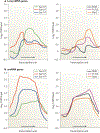Unravelling the means to an end: RNA polymerase II transcription termination
- PMID: 21487437
- PMCID: PMC6995273
- DOI: 10.1038/nrm3098
Unravelling the means to an end: RNA polymerase II transcription termination
Abstract
The pervasiveness of RNA synthesis in eukaryotes is largely the result of RNA polymerase II (Pol II)-mediated transcription, and termination of its activity is necessary to partition the genome and maintain the proper expression of neighbouring genes. Despite its ever-increasing biological significance, transcription termination remains one of the least understood processes in gene expression. However, recent mechanistic studies have revealed a striking convergence among several overlapping models of termination, including the poly(A)- and Sen1-dependent pathways, as well as new insights into the specificity of Pol II termination among its diverse gene targets. Broader knowledge of the role of Pol II carboxy-terminal domain phosphorylation in promoting alternative mechanisms of termination has also been gained.
Figures




References
-
- Lee TI & Young RA Transcription of eukaryotic protein-coding genes. Annu. Rev. Genet 34, 77–137 (2000). - PubMed
-
- Espinosa JM The meaning of pausing. Mol. Cell 40, 507–508 (2010). - PubMed
-
- Rosonina E, Kaneko S. & Manley JL Terminating the transcript: breaking up is hard to do. Genes Dev. 20, 1050–1056 (2006). - PubMed
-
- Gilmour DS & Fan R. Derailing the locomotive: transcription termination. J. Biol. Chem 283, 661–664 (2008). - PubMed
Publication types
MeSH terms
Substances
Grants and funding
LinkOut - more resources
Full Text Sources
Other Literature Sources

